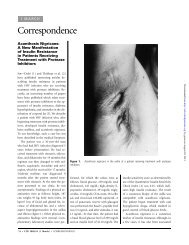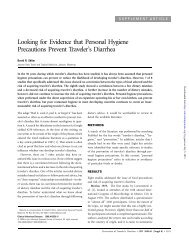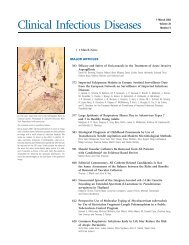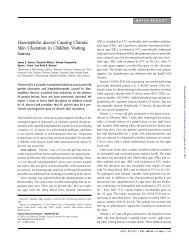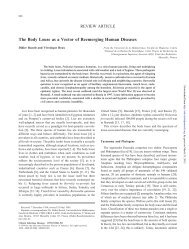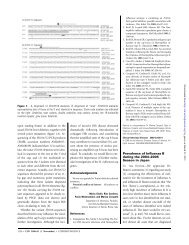Effect of Antipyretic Drugs in Children with Malaria - Clinical ...
Effect of Antipyretic Drugs in Children with Malaria - Clinical ...
Effect of Antipyretic Drugs in Children with Malaria - Clinical ...
Create successful ePaper yourself
Turn your PDF publications into a flip-book with our unique Google optimized e-Paper software.
BRIEF REPORT<br />
<strong>Effect</strong> <strong>of</strong> <strong>Antipyretic</strong> <strong>Drugs</strong> <strong>in</strong> <strong>Children</strong><br />
<strong>with</strong> <strong>Malaria</strong><br />
Bertrand Lell, 1,2,3,a Milena Sovric, 1,2,a Daniela Schmid, 1 Doris Luckner, 1,2<br />
Klaus Herbich, 1 Hua Yan Long, 2 Wolfgang Gran<strong>in</strong>ger, 3<br />
and Peter G. Kremsner 1,2<br />
1 Research Unit, Albert Schweitzer Hospital, Lambaréné, Gabon; 2 Department<br />
<strong>of</strong> Parasitology, Institute <strong>of</strong> Tropical Medic<strong>in</strong>e, University <strong>of</strong> Tüb<strong>in</strong>gen, Tüb<strong>in</strong>gen,<br />
Germany; 3 Department <strong>of</strong> Infectious Diseases, Internal Medic<strong>in</strong>e I, University<br />
<strong>of</strong> Vienna, Vienna, Austria<br />
A comparison <strong>of</strong> different antipyretics <strong>in</strong> children <strong>with</strong> malaria<br />
showed a small effect <strong>of</strong> naproxen, but not <strong>of</strong> metamizol,<br />
on the reduction <strong>of</strong> fever peaks. <strong>Antipyretic</strong> treatment had<br />
no effect on fever clearance and therefore should be used<br />
cautiously <strong>in</strong> the treatment <strong>of</strong> malaria.<br />
Fever is the most apparent sign dur<strong>in</strong>g an acute malaria attack<br />
and can be accompanied by other nonspecific symptoms such<br />
as headache, diarrhea, abdom<strong>in</strong>al pa<strong>in</strong>, vomit<strong>in</strong>g, and nausea.<br />
The physiological role <strong>of</strong> fever <strong>in</strong> malaria and other <strong>in</strong>fectious<br />
diseases rema<strong>in</strong>s unclear [1], and the value <strong>of</strong> reduc<strong>in</strong>g fever<br />
<strong>in</strong> children <strong>with</strong> malaria is controversial [2]. To control fever,<br />
the World Health Organization [3] recommends mechanical<br />
measures such as fann<strong>in</strong>g, tepid spong<strong>in</strong>g, and cool<strong>in</strong>g blankets.<br />
In addition to antimalarial chemotherapy, patients usually also<br />
receive antipyretic treatment to keep fever low [4], despite<br />
grow<strong>in</strong>g doubts about the need for this practice [5].<br />
Data from Kwiatkowski [6] and our own recent <strong>in</strong> vitro data<br />
show that <strong>in</strong>creased temperatures, which correspond to febrile<br />
temperatures <strong>in</strong> humans, <strong>in</strong>hibit the growth <strong>of</strong> Plasmodium<br />
falciparum. It seems that malarial fever is a beneficial reaction<br />
<strong>of</strong> the host to combat the <strong>in</strong>fection by kill<strong>in</strong>g or <strong>in</strong>hibit<strong>in</strong>g<br />
Received 11 May 2000; revised 28 July 2000; electronically published 23 February 2001.<br />
Informed consent was obta<strong>in</strong>ed from the parents or guardians <strong>of</strong> all children participat<strong>in</strong>g<br />
<strong>in</strong> the study, and the study was approved by the Ethics Committee, International Foundation<br />
<strong>of</strong> Albert Schweitzer Hospital (Lambaréné, Gabon).<br />
Grant support: This study was supported by a ƒortüne grant from the Medical Faculty,<br />
University <strong>of</strong> Tüb<strong>in</strong>gen, Tüb<strong>in</strong>gen, Germany, and by a grant from Gesellschaft für<br />
Chemotherapie, Vienna, Austria.<br />
a B.L. and M.S. contributed equally to this work.<br />
Repr<strong>in</strong>ts or correspondence: Pr<strong>of</strong>essor Peter Kremsner, Institut für Tropenmediz<strong>in</strong>,<br />
Wilhelmstrasse 27, D-72074 Tüb<strong>in</strong>gen, Germany (peter.kremsner@uni-tueb<strong>in</strong>gen.de).<br />
Cl<strong>in</strong>ical Infectious Diseases 2001; 32:838–41<br />
� 2001 by the Infectious Diseases Society <strong>of</strong> America. All rights reserved.<br />
1058-4838/2001/3205-0027$03.00<br />
838 • CID 2001:32 (1 March) • BRIEF REPORTS<br />
growth <strong>of</strong> the parasite. Thus, reduc<strong>in</strong>g fever could have negative<br />
effects on the course <strong>of</strong> the disease.<br />
We first attempted to test this hypothesis <strong>in</strong> children treated<br />
<strong>with</strong> acetam<strong>in</strong>ophen [7]. However, it was not possible to reduce<br />
malarial fever <strong>with</strong> this drug, and treatment <strong>with</strong> acetam<strong>in</strong>ophen<br />
was even associated <strong>with</strong> prolonged parasite clearance<br />
times, possibly by decreas<strong>in</strong>g the production <strong>of</strong> TNF and oxygen<br />
radicals.<br />
The present study <strong>in</strong>vestigated the relationship among fever,<br />
parasite clearance, and immunologic markers (production <strong>of</strong><br />
cytok<strong>in</strong>es and oxygen radicals) <strong>with</strong> use <strong>of</strong> 2 other nonsteroidal<br />
antipyretic drugs. Metamizol, a pyrazolone derivative, was chosen<br />
because it is widely used to treat fever <strong>in</strong> Africa. Naproxen,<br />
a propionic acid derivative similar to ibupr<strong>of</strong>en, was used because<br />
<strong>of</strong> its reported efficacy aga<strong>in</strong>st childhood fevers [8]. Both<br />
agents have a similar mode <strong>of</strong> action through the <strong>in</strong>hibition <strong>of</strong><br />
cyclo-oxygenase and subsequent prostagland<strong>in</strong> synthesis.<br />
Methods. The study was done at Albert Schweitzer Hospital<br />
<strong>in</strong> Lambaréné, Gabon, which is located <strong>in</strong> an area where<br />
P. falciparum is highly endemic [9]. Patients attend<strong>in</strong>g the outpatient<br />
cl<strong>in</strong>ic between October 1997 and July 1998 were <strong>in</strong>cluded<br />
<strong>in</strong> the study if they had uncomplicated P. falciparum<br />
malaria and met the follow<strong>in</strong>g criteria: 2–7 years <strong>of</strong> age; asexual<br />
parasitemia (20,000–200,000 parasites/mL <strong>of</strong> blood); temperature<br />
<strong>of</strong> 138�C at admission or fever dur<strong>in</strong>g the preced<strong>in</strong>g 24<br />
h; no antipyretic treatment dur<strong>in</strong>g the preced<strong>in</strong>g 8 h; and no<br />
effective antimalarial treatment for the current <strong>in</strong>fection, as<br />
confirmed by ur<strong>in</strong>e tests for chloroqu<strong>in</strong>e and qu<strong>in</strong><strong>in</strong>e (Wilson<br />
and Edeson test) and for sulfonamides (Lign<strong>in</strong> test). Because<br />
<strong>of</strong> the high level <strong>of</strong> chloroqu<strong>in</strong>e resistance <strong>in</strong> the area, patients<br />
<strong>with</strong> a history <strong>of</strong> treatment <strong>with</strong> low doses <strong>of</strong> chloroqu<strong>in</strong>e were<br />
eligible for <strong>in</strong>clusion <strong>in</strong> the study. Patients were not <strong>in</strong>cluded<br />
<strong>in</strong> the study if they had complicated malaria, as def<strong>in</strong>ed by any<br />
<strong>of</strong> the follow<strong>in</strong>g criteria: hemoglob<strong>in</strong> level, !8.0 g/dL; packed-<br />
9<br />
cell volume, !24%; leukocyte count, 112 � 10 cells/L; glucose<br />
level, !50 mg/dL; lactate level, 13.5 mM; schizontemia, 150<br />
9<br />
shizonts/mL; platelet count, ! 50 � 10 cells/L; and signs <strong>of</strong> other<br />
concomitant <strong>in</strong>fection or other severe disease. Patients <strong>with</strong><br />
12% pigment-conta<strong>in</strong><strong>in</strong>g neutrophils were excluded from the<br />
study, to prevent the enrollment <strong>of</strong> patients <strong>with</strong> highly synchronized<br />
parasite populations hidden <strong>in</strong> the deep vasculature<br />
[10, 11]. <strong>Children</strong> were excluded from the study when they<br />
had a history <strong>of</strong> febrile or afebrile convulsions.<br />
Patients were hospitalized until 2 successive thick blood<br />
smears were negative. All patients received an <strong>in</strong>fusion <strong>of</strong> 5%<br />
glucose <strong>with</strong> 12 mg/kg <strong>of</strong> qu<strong>in</strong><strong>in</strong>e dihydrochloride every 12 h.<br />
Downloaded from<br />
http://cid.oxfordjournals.org/ by guest on February 12, 2013
A s<strong>in</strong>gle oral dose <strong>of</strong> sulfadox<strong>in</strong>e/pyrimetham<strong>in</strong>e was given at<br />
the time <strong>of</strong> discharge.<br />
Patients were randomly assigned to 1 <strong>of</strong> 3 antipyretic treatment<br />
groups by means <strong>of</strong> a random-numbers table: mechanical<br />
antipyretic treatment consist<strong>in</strong>g <strong>of</strong> cont<strong>in</strong>uous electric fann<strong>in</strong>g<br />
and tepid spong<strong>in</strong>g when rectal temperatures rose above 37.5�C;<br />
metamizol treatment adm<strong>in</strong>istered by mouth at a dosage <strong>of</strong> 10<br />
mg/kg every 6 h, <strong>in</strong> addition to mechanical antipyresis as described<br />
above; and naproxen treatment adm<strong>in</strong>istered as rectal<br />
suppositories at a dosage <strong>of</strong> 7.5 mg/kg every 12 h, <strong>in</strong> addition<br />
to mechanical antipyresis as described above. Expelled suppositories<br />
were immediately readm<strong>in</strong>istered.<br />
At the time <strong>of</strong> admission (day 0) and each subsequent day,<br />
complete physical exam<strong>in</strong>ation was done, and signs and symptoms<br />
were recorded. Rectal body temperature was measured at<br />
admission and then hourly until discharge (<strong>in</strong> 19 cases, temperature<br />
was measured only every 6 h). Parasitemia was measured<br />
through a Giemsa-sta<strong>in</strong>ed thick blood smear by a direct<br />
method described elsewhere [12]. This was performed on admission<br />
and then every 6 h until 2 consecutive blood smears<br />
were negative. Capillary blood samples were obta<strong>in</strong>ed on days<br />
0 and 3 for laboratory exam<strong>in</strong>ation, to determ<strong>in</strong>e the follow<strong>in</strong>g:<br />
hemoglob<strong>in</strong> level, packed-cell volume, leukocyte and platelet<br />
counts, glucose level, and lactate level.<br />
Venous blood samples (3 mL) were obta<strong>in</strong>ed <strong>in</strong> EDTA-conta<strong>in</strong><strong>in</strong>g<br />
tubes before the start <strong>of</strong> treatment and 24, 48, and 72<br />
h thereafter for the measurement <strong>of</strong> plasma levels <strong>of</strong> TNF, IFNg,<br />
IL-10, and IL-12. In addition, TNF levels were measured, at<br />
the same times, <strong>in</strong> supernatants <strong>of</strong> stimulated whole blood.<br />
Immediately after venipuncture, 2 mL <strong>of</strong> whole blood was stimulated<br />
<strong>with</strong> phytohemagglut<strong>in</strong><strong>in</strong> (10 mg/mL; Sigma) or lipopolysaccharide<br />
(0.1 mg/mL; Sigma). After 2 h <strong>of</strong> <strong>in</strong>cubation at<br />
37.5�C, supernatants were harvested and stored at �20�C until<br />
measurement <strong>of</strong> cytok<strong>in</strong>e levels. All cytok<strong>in</strong>e levels were determ<strong>in</strong>ed<br />
by ELISA (Flexia, Biosource) accord<strong>in</strong>g to the manufacturer’s<br />
<strong>in</strong>structions.<br />
Immediately after venisection, the production <strong>of</strong> oxygen radicals<br />
was measured by addition <strong>of</strong> 10 mL <strong>of</strong> whole blood to<br />
Krebs-R<strong>in</strong>ger-phosphate-glucose buffer conta<strong>in</strong><strong>in</strong>g 0.1 mg/mL<br />
phorbolmyristate acetate (Sigma) and 11 mM lum<strong>in</strong>ol (Sigma)<br />
[13]. Lum<strong>in</strong>escence was measured <strong>with</strong> a lum<strong>in</strong>ometer (Lumat,<br />
EG&G Berthold). The <strong>in</strong>duction <strong>of</strong> oxygen radicals was expressed<br />
<strong>in</strong> relative light units per second and was recorded every<br />
5 m<strong>in</strong> until peak values were reached.<br />
Parasite clearance time was def<strong>in</strong>ed as the time <strong>in</strong> hours from<br />
admission until the first <strong>of</strong> 2 consecutive negative thick blood<br />
smears. Fever was assessed <strong>in</strong> 2 ways: fever clearance time,<br />
def<strong>in</strong>ed as duration <strong>in</strong> hours from admission to the first time<br />
a patient’s temperature stabilized below an <strong>in</strong>dicated fever<br />
threshold; and fever time, def<strong>in</strong>ed as duration <strong>in</strong> hours that an<br />
<strong>in</strong>dividual’s temperature was above an <strong>in</strong>dicated fever thresh-<br />
old. A patient <strong>with</strong> only 1 fever peak very late <strong>in</strong> the course <strong>of</strong><br />
<strong>in</strong>fection would thus have a long fever clearance time but a<br />
short fever time. This form <strong>of</strong> analysis was done because our<br />
<strong>in</strong> vitro study had shown that the extent <strong>of</strong> <strong>in</strong>hibition <strong>of</strong> growth<br />
<strong>of</strong> P. falciparum depends on the time <strong>of</strong> exposure to febrile<br />
temperatures (authors’ unpublished data).<br />
Differences between the treatment groups were assessed by<br />
the Kruskal-Wallis nonparametric test or by analysis <strong>of</strong> variance<br />
<strong>with</strong> Dunnett’s procedure for post hoc comparisons. The Wilcoxon<br />
signed rank test was used to assess differences between<br />
time po<strong>in</strong>ts <strong>with</strong><strong>in</strong> a group. Correlations were calculated us<strong>in</strong>g<br />
Spearman’s rank correlation. Two-sided P values <strong>of</strong> !.05 were<br />
considered significant.<br />
Results. N<strong>in</strong>ety patients (30 patients per group) were enrolled<br />
<strong>in</strong> the study. The 3 groups were similar at admission<br />
<strong>with</strong> respect to demographics and cl<strong>in</strong>ical and laboratory data<br />
(data not shown). All children recovered completely, and there<br />
were no differences <strong>in</strong> terms <strong>of</strong> adverse events dur<strong>in</strong>g hospitalization<br />
<strong>in</strong> the 3 treatment groups.<br />
At the time <strong>of</strong> admission, rectal temperatures were similar<br />
<strong>in</strong> all 3 groups. After the start <strong>of</strong> treatment, 28, 29, and 27<br />
patients <strong>in</strong> the mechanical antipyretic, metamizol, and naproxen<br />
treatment groups, respectively, had temperatures <strong>of</strong><br />
138.0�C, and 14, 10, and 14 patients, respectively, had temperatures<br />
<strong>of</strong> 140�C. In contrast to metamizol, naproxen consistently<br />
reduced fever clearance times over a wide range <strong>of</strong><br />
fever thresholds (37.8�C, 38�C, 38.5 �C, and 39.5 �C). However,<br />
this reduction was significant only at a fever threshold <strong>of</strong> 38.0�C<br />
(mechanical antipyresis, 39 h; metamizol treatment, 39 h; naproxen<br />
treatment, 24 h; figure 1). The fever time was significantly<br />
lower for children receiv<strong>in</strong>g naproxen treatment (4.5 h<br />
at a fever threshold <strong>of</strong> 38.5�C; P p .009)<br />
than for those receiv<strong>in</strong>g<br />
mechanical antipyresis (10.4 h at a fever threshold <strong>of</strong><br />
Figure 1. Mean fever clearance times and fever times at different<br />
fever thresholds <strong>in</strong> 3 groups <strong>of</strong> children <strong>with</strong> malaria who were treated<br />
<strong>with</strong> mechanical antipyresis only (black bar), metamizol (gray bar), or<br />
naproxen (white bar). Vertical l<strong>in</strong>es project<strong>in</strong>g from bars <strong>in</strong>dicate upper<br />
95% CI. * P ! .05,<br />
compared <strong>with</strong> mechanical antipyresis.<br />
BRIEF REPORTS • CID 2001:32 (1 March) • 839<br />
Downloaded from<br />
http://cid.oxfordjournals.org/ by guest on February 12, 2013
38.5�C). This f<strong>in</strong>d<strong>in</strong>g was significant over a wide range <strong>of</strong> fever<br />
thresholds (37.8�C, 38�C, 38.5�C, 39�C, 39.5�C, and 40�C).<br />
Treatment <strong>with</strong> metamizol led to shorten<strong>in</strong>g <strong>of</strong> the fever time<br />
at any fever threshold (6.8 h at a fever threshold <strong>of</strong> 38.5�C),<br />
but this decrease was never significant compared <strong>with</strong> that associated<br />
<strong>with</strong> mechanical antipyresis.<br />
At admission, body temperature and parasitemia were significantly<br />
correlated ( r p .34; P p .002).<br />
Twelve and 18 h after<br />
the onset <strong>of</strong> therapy, however, they were clearly <strong>in</strong>versely correlated<br />
( r p �.46 and P ! .001 and r p �.26 and P p .015,<br />
respectively).<br />
The mean time to parasite clearance was 63 h, <strong>with</strong> no<br />
significant difference <strong>in</strong> the time to parasite clearance <strong>in</strong> any<br />
treatment group (mechanical antipyresis, 60 h; metamizol treatment,<br />
63 h; naproxen treatment, 66 h). Even though parasitemia<br />
<strong>in</strong> the mechanical treatment group was consistently lower<br />
than that <strong>in</strong> the naproxen treatment group dur<strong>in</strong>g the first 30<br />
h <strong>of</strong> treatment, the difference was not significant (figure 2).<br />
The <strong>in</strong>itial clearance <strong>of</strong> parasitemia was faster <strong>in</strong> the mechanical<br />
treatment group, <strong>in</strong> which parasitemia already had decreased<br />
significantly 6 h ( P p .047) and 12 h ( P p .008)<br />
after the start<br />
<strong>of</strong> treatment, compared <strong>with</strong> parasitemia at admission. In both<br />
the metamizol and naproxen treatment groups, a significant<br />
decrease was first observed 18 h after the start <strong>of</strong> treatment.<br />
A simple correlation between fever and parasite clearance<br />
times is not mean<strong>in</strong>gful, s<strong>in</strong>ce long courses <strong>of</strong> parasitemia necessarily<br />
lead to long courses <strong>of</strong> fever, as shown by a positive<br />
correlation between the 2 variables <strong>in</strong> our study ( r p .74;<br />
fever<br />
threshold, 38.5�C). To determ<strong>in</strong>e the effect <strong>of</strong> fever on the<br />
course <strong>of</strong> parasitemia, we corrected for the duration <strong>of</strong> parasitemia<br />
by calculat<strong>in</strong>g the proportion <strong>of</strong> time <strong>with</strong> parasitemia<br />
dur<strong>in</strong>g which fever occurred (fever time/parasite clearance<br />
time). No correlation between the corrected fever time and the<br />
parasite clearance time was found for any fever threshold<br />
( r p .02;<br />
fever threshold, 38.5�C).<br />
In all patients, plasma levels <strong>of</strong> the cytok<strong>in</strong>es TNF, IFN-g, IL-<br />
10, and IL-12 were elevated at admission. No significant differences<br />
among the treatment groups were seen at any time po<strong>in</strong>t.<br />
Parasitemia at admission was significantly positively correlated<br />
<strong>with</strong> plasma levels <strong>of</strong> TNF ( r p .28) and IL-10 ( r p .43)<br />
and<br />
negatively correlated <strong>with</strong> plasma levels <strong>of</strong> IL-12 (r p �.25). On<br />
all 3 days, temperature was highly correlated <strong>with</strong> plasma levels<br />
<strong>of</strong> both IL-10 ( r p .78 on day 1 to r p .44 on day 4) and IFN-<br />
g ( r p .29 on day 1 to r p .39 on day 4). No consistent cor-<br />
relations over time were found <strong>with</strong> the other cytok<strong>in</strong>es.<br />
There were no significant differences <strong>in</strong> phytohemagglut<strong>in</strong><strong>in</strong>and<br />
lipopolysaccharide-<strong>in</strong>duced TNF concentrations between<br />
the 3 treatment groups at any time. A common feature <strong>in</strong> all<br />
90 cases was that ex vivo cytok<strong>in</strong>e production 48 h after the<br />
onset <strong>of</strong> therapy was significantly greater than cytok<strong>in</strong>e production<br />
at admission.<br />
840 • CID 2001:32 (1 March) • BRIEF REPORTS<br />
Figure 2. Course <strong>of</strong> parasitemia <strong>in</strong> 3 groups <strong>of</strong> children <strong>with</strong> malaria<br />
who were treated <strong>with</strong> mechanical antipyresis only (�), metamizol (�),<br />
or naproxen (�).<br />
Lipopolysaccharide-<strong>in</strong>duced TNF production at admission<br />
was significantly <strong>in</strong>versely correlated <strong>with</strong> parasite clearance<br />
time ( r p �.30; P p .028).<br />
There were no significant differences <strong>in</strong> production <strong>of</strong> oxygen<br />
radicals between the 3 antipyretic treatment groups on any day.<br />
Peak production and the time <strong>of</strong> peak production were also<br />
similar <strong>in</strong> the 3 treatment groups (data not shown).<br />
Discussion. A previous study from our group showed that<br />
it is not possible to reduce malarial fever <strong>with</strong> acetam<strong>in</strong>ophen<br />
[7]. In the present study, drugs <strong>with</strong> antipyretic properties that<br />
are generally thought to be superior to those <strong>of</strong> acetam<strong>in</strong>ophen<br />
were used to determ<strong>in</strong>e whether it is possible to reduce malarial<br />
fever and whether a reduction has an effect on the course <strong>of</strong><br />
parasitemia. The results show that treatment <strong>with</strong> naproxen<br />
can, to some extent, lead to faster fever clearance than treatment<br />
<strong>with</strong> metamizol, which had no effect. The antipyretic effect <strong>of</strong><br />
naproxen was more pronounced, as shown by the drug’s ability<br />
to reduce a child’s fever time, suggest<strong>in</strong>g that the drug exerts<br />
its effect ma<strong>in</strong>ly by suppress<strong>in</strong>g fever peaks rather than by<br />
clear<strong>in</strong>g malarial fever. If antipyretic treatment for malarial fever<br />
is desired, then naproxen is preferable to either acetam<strong>in</strong>ophen<br />
or metamizol.<br />
The question <strong>of</strong> whether reduction <strong>of</strong> fever is cl<strong>in</strong>ically mean<strong>in</strong>gful<br />
rema<strong>in</strong>s. Animal studies have shown both the beneficial<br />
effect <strong>of</strong> fever and the negative effect <strong>of</strong> antipyretic treatment<br />
<strong>in</strong> the course <strong>of</strong> <strong>in</strong>fectious diseases (reviewed <strong>in</strong> [14]).<br />
Cl<strong>in</strong>ical studies <strong>in</strong>volv<strong>in</strong>g humans suggested a beneficial effect<br />
<strong>of</strong> fever on sepsis [15] and bacterial peritonitis [16] and a<br />
negative effect <strong>of</strong> treatment <strong>with</strong> antipyretics on rh<strong>in</strong>ovirus [17]<br />
and varicella-zoster virus [18] <strong>in</strong>fections. The present study<br />
shows that differences <strong>in</strong> body temperature do not lead to<br />
differences <strong>in</strong> the course <strong>of</strong> P. falciparum parasitemia. This f<strong>in</strong>d<strong>in</strong>g<br />
is surpris<strong>in</strong>g <strong>in</strong> view <strong>of</strong> the clear results <strong>of</strong> <strong>in</strong> vitro studies<br />
<strong>of</strong> this parasite, which showed a strong growth <strong>in</strong>hibitory effect<br />
Downloaded from<br />
http://cid.oxfordjournals.org/ by guest on February 12, 2013
at febrile temperatures [6]. The time spent <strong>with</strong> febrile temperatures<br />
may not have been long enough for a visible effect.<br />
Our <strong>in</strong> vitro studies showed that a 6-h exposure to temperatures<br />
<strong>of</strong> 40�C at late stages leads to significant growth <strong>in</strong>hibition.<br />
Longer exposure is needed to <strong>in</strong>hibit parasite growth at 39�C.<br />
In the present study, however, only 6 patients (7%) had a<br />
cumulative exposure to temperatures <strong>of</strong> 140�C for at least 6 h,<br />
and 20 (22%) had an exposure to temperatures <strong>of</strong> 139�C for<br />
this period <strong>of</strong> time. One reason for the small numbers <strong>of</strong> patients<br />
exposed to these temperatures might have been the exclusion<br />
<strong>of</strong> patients <strong>with</strong> severe malaria, who presumably would<br />
have higher temperatures or prolonged fever. Furthermore, an<br />
effect <strong>of</strong> fever on the course <strong>of</strong> parasitemia would be masked<br />
by the effect <strong>of</strong> qu<strong>in</strong><strong>in</strong>e, which is undoubtedly much more<br />
effective aga<strong>in</strong>st P. falciparum than are febrile temperatures;<br />
thus, a beneficial effect <strong>of</strong> fever on parasitemia perhaps could<br />
be seen <strong>in</strong> yet untreated malaria.<br />
<strong>Antipyretic</strong>s are commonly given to children <strong>with</strong> <strong>in</strong>fectious<br />
diseases, to prevent febrile convulsions. However, <strong>with</strong> P. falciparum<br />
malaria, <strong>in</strong> which convulsions are common, more than<br />
one-half <strong>of</strong> convulsions occur at rectal temperatures <strong>of</strong> !38�C,<br />
suggest<strong>in</strong>g that the <strong>in</strong>fection, not the fever, <strong>in</strong>duces convulsions<br />
(which thus cannot be prevented by reduc<strong>in</strong>g fever) [19].<br />
Plasma levels <strong>of</strong> TNF and IFN-g were, not surpris<strong>in</strong>gly, associated<br />
<strong>with</strong> fever. In addition, we found a high correlation<br />
between plasma levels <strong>of</strong> IL-10 and body temperature. TNF<br />
leads to the production <strong>of</strong> IL-10, which suggests a rapid<br />
counterregulatory response to <strong>in</strong>flammatory and pyrogenic cytok<strong>in</strong>es<br />
<strong>in</strong> these children <strong>with</strong> mild malaria [20].<br />
Our earlier study showed decreased production <strong>of</strong> radical<br />
oxygen <strong>in</strong>termediates after acetam<strong>in</strong>ophen treatment [7]. Treatment<br />
<strong>with</strong> naproxen or metamizol did not lead to a comparable<br />
phenomenon.<br />
The positive correlation between temperature and parasitemia<br />
that we found at admission has been described earlier<br />
for a large population [21]. The <strong>in</strong>itial drop <strong>in</strong> parasitemia was<br />
faster <strong>in</strong> the mechanical antipyretic treatment group than <strong>in</strong><br />
the other treatment groups. The reason for this f<strong>in</strong>d<strong>in</strong>g rema<strong>in</strong>s<br />
unexpla<strong>in</strong>ed; however, the effect was not due to fever or production<br />
<strong>of</strong> cytok<strong>in</strong>es or oxygen radicals, s<strong>in</strong>ce there was no<br />
significant difference <strong>in</strong> these parameters between the treatment<br />
groups dur<strong>in</strong>g the first 6 h <strong>of</strong> therapy. An effect <strong>of</strong> the drugs<br />
themselves was excluded by <strong>in</strong> vitro studies show<strong>in</strong>g no effect<br />
<strong>of</strong> metamizol or naproxen treatment on the growth <strong>of</strong> P. falciparum<br />
(authors’ unpublished data).<br />
Taken together, the benefits from not tak<strong>in</strong>g antipyretics do<br />
not seem large. However, the relative <strong>in</strong>effectiveness <strong>of</strong> commonly<br />
used antipyretics, the high risk <strong>of</strong> overdos<strong>in</strong>g [22], and<br />
the need to reduce drug <strong>in</strong>teractions strongly argue aga<strong>in</strong>st the<br />
widespread practice <strong>of</strong> giv<strong>in</strong>g adjuvant antipyretic drugs <strong>in</strong>discrim<strong>in</strong>ately<br />
to every child <strong>with</strong> P. falciparum malaria.<br />
Acknowledgments<br />
We thank the children and their parents or guardians for<br />
their participation <strong>in</strong> this study and the staff <strong>of</strong> Albert Schweitzer<br />
Hospital (Lambaréné, Gabon) for their support.<br />
References<br />
1. Kwiatkowski D. <strong>Malaria</strong>l tox<strong>in</strong>s and the regulation <strong>of</strong> parasite density.<br />
Parasitol Today 1995; 11:206–12.<br />
2. Kluger MJ. <strong>Drugs</strong> for childhood fever. Lancet 1992; 339:70.<br />
3. World Health Organization. Severe and complicated malaria. Trans R<br />
Soc Trop Med Hyg 1990; 84(Suppl 2):1–65.<br />
4. White NJ. The treatment <strong>of</strong> malaria. N Engl J Med 1996; 335:800–6.<br />
5. Kluger MJ, Kozak W, Conn A, Leon LR, Soszynski D. The adaptive<br />
value <strong>of</strong> fever. Infect Dis Cl<strong>in</strong> North Am 1996; 10:1–20.<br />
6. Kwiatkowski D. Febrile temperatures can synchronize the growth <strong>of</strong><br />
Plasmodium falciparum <strong>in</strong> vitro. J Exp Med 1989; 169:357–61.<br />
7. Brandts CH, Ndjavé M, Gran<strong>in</strong>ger W, et al. <strong>Effect</strong> <strong>of</strong> paracetamol on<br />
parasite clearance time <strong>in</strong> Plasmodium falciparum malaria. Lancet<br />
1997; 350:704–9.<br />
8. Cashman TM, Starus R, Johnson J, et al. Comparative effects <strong>of</strong> naproxen<br />
and aspir<strong>in</strong> on fever <strong>in</strong> children. J Pediatr 1979; 95:626–9.<br />
9. Wildl<strong>in</strong>g E, W<strong>in</strong>kler S, Kremsner PG, et al. <strong>Malaria</strong> epidemiology <strong>in</strong> the<br />
prov<strong>in</strong>ce <strong>of</strong> Moyen Ogooué, Gabon. Trop Med Parasitol 1995; 46:77–82.<br />
10. Nguyen HP, Day N, Pham TP, et al. Intraleucocytic malaria pigment<br />
and prognosis <strong>in</strong> severe malaria. Trans R Soc Trop Med Hyg 1995; 89:<br />
200–4.<br />
11. Metzger WG, Mordmüller BG, Kremsner PG. <strong>Malaria</strong> pigment <strong>in</strong> leucocytes.<br />
Trans R Soc Trop Med Hyg 1995; 89:637–8.<br />
12. Kremsner PG, Zotter GM, Feldmeier H, et al. A comparative trial <strong>of</strong><br />
three regimens for treat<strong>in</strong>g uncomplicated falciparum malaria <strong>in</strong> Acre,<br />
Brazil. J Infect Dis 1988; 158:1368–71.<br />
13. Johansson A, Dahlgren C. Characterization <strong>of</strong> lum<strong>in</strong>ol-amplified light<br />
generat<strong>in</strong>g reaction <strong>in</strong>duced by human monocytes. J Leukoc Biol<br />
1989; 45:444–51.<br />
14. Kluger MJ, Kozak W, Conn CA, et al. The adaptive value <strong>of</strong> fever. In:<br />
Mackowiak P, ed. Fever: basic mechanisms and management. 2d ed.<br />
Philadelphia: Lipp<strong>in</strong>cott-Raven, 1997.<br />
15. Mackowiak PA, Browne RH, Southern PM, et al. Polymicrobial sepsis;<br />
analysis <strong>of</strong> 184 cases us<strong>in</strong>g log l<strong>in</strong>ear models. Am J Med Sci 1980; 280:<br />
73–80.<br />
16. We<strong>in</strong>ste<strong>in</strong> MR, Iann<strong>in</strong>i PB, Staton CW, et al. Spontaneous bacterial<br />
peritonitis: a review <strong>of</strong> 28 cases <strong>with</strong> emphasis on improved survival<br />
and factors <strong>in</strong>fluenc<strong>in</strong>g prognosis. Am J Med 1978; 64:592–8.<br />
17. Graham MH, Burrell CJ, Douglas RM, et al. Adverse effects <strong>of</strong> aspir<strong>in</strong>,<br />
acetam<strong>in</strong>ophen, and ibupr<strong>of</strong>en on immune function, viral shedd<strong>in</strong>g,<br />
and cl<strong>in</strong>ical status <strong>in</strong> rh<strong>in</strong>ovirus-<strong>in</strong>fected volunteers. J Infect Dis<br />
1990; 162:1277–82.<br />
18. Dorn TF, DeAngelis C, Baumgartner RA, et al. Acetam<strong>in</strong>ophen: more<br />
harm than good for chicken pox? J Pediatr 1989; 114:1045–8.<br />
19. Waruiru CM, Newton CRJC, Forster D, et al. Epileptic seizures and<br />
malaria <strong>in</strong> Kenyan children. Trans R Soc Trop Med Hyg 1996; 90:152–5.<br />
20. Wanidworanun C, Strober W. Predom<strong>in</strong>ant role <strong>of</strong> tumor necrosis<br />
factor-alpha <strong>in</strong> human monocyte IL-10 synthesis. J Immunol 1993;<br />
151:6853–61.<br />
21. Delf<strong>in</strong>i LF. The relationship between body temperature and malaria<br />
parasitaemia <strong>in</strong> rural forest areas <strong>of</strong> western Nigeria. J Trop Med Hyg<br />
1973; 76:111–4.<br />
22. English M, Marsh V, Amukoye E, et al. Chronic salicylate poison<strong>in</strong>g<br />
and severe malaria. Lancet 1996; 347:1736–7.<br />
BRIEF REPORTS • CID 2001:32 (1 March) • 841<br />
Downloaded from<br />
http://cid.oxfordjournals.org/ by guest on February 12, 2013



